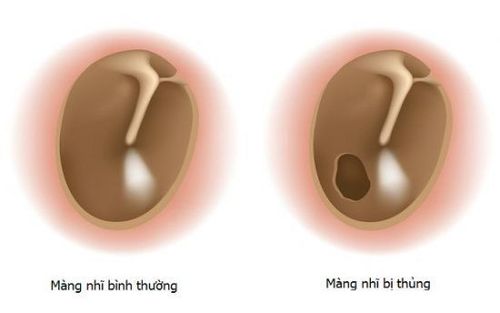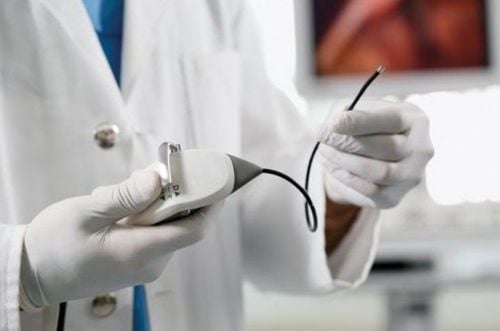This is an automatically translated article.
The article was professionally consulted by Specialist Doctor of Otolaryngology - Department of Medical Examination and Internal Medicine - Vinmec Ha Long International Hospital. The doctor has more than 10 years of experience in examining and treating ENT diseases of adults and children.
Hearing is a sense that plays a very important role in the relationship between people and the world around them. In which, the eardrum is an indispensable element. The eardrum is a closed membrane that separates the middle ear from the outer ear. It conducts sound and protects the middle ear from bacteria and foreign matter. So is the eardrum easily perforated and can the perforation of the eardrum heal on its own?
1. Structure of the human eardrum
The eardrum is very thin, semi-transparent, elliptical, and slightly concave. The eardrum size is: about 9mm high, about 8mm wide and about 0.1mm thick. The anterior-lower part of the tympanic membrane is tilted slightly inward, creating an angle of about 45 to 50 degrees with the base of the external ear canal. The human eardrum is composed of 3 layers: the outer epidermis, the middle fibrous tissue layer, and the inner mucosal layer. In children, the eardrum is thin and elastic, becoming thicker and stiffer as an adult.
When there are vibrations of sound, the sound energy is gradually increased by the auricle and the resonance of the ear canal, making it easier for the eardrum to move back and forth, in response to the vibrations.

2. Why is the eardrum easy to perforate?
The function of the eardrum is to receive sound waves from the outside, create vibrations and then transmit them through the ossicle chain, to the sensory cells in the inner ear. The mechanical vibrations will turn into electrical impulses that are transmitted to the brain. To do a good job of transmitting sound, the eardrum must be intact, keeping the necessary thinness and elasticity.
Due to the very thin eardrum, when picking, removing wax or foreign objects in the ear, if you are not careful, the eardrum can be punctured. During surgery on the stapes in the ear or during trauma with a craniotemporal fracture can also lead to a ruptured eardrum. Even in the case of a sudden change in air pressure, when the plane changes altitude, it can also damage the eardrum if those passengers are suffering from a blocked ear canal.
When trauma has a strong and direct impact on the ear canal (for example, being hit by a ball while playing football, volleyball, tennis or being slapped hard in the right ear area), causing a sudden increase in air pressure in the outer ear canal can tear the eardrum.
In addition to trauma, a perforated eardrum can also be caused by otitis media. When the middle ear is inflamed, pus accumulates a lot until a certain time, the eardrum and capillary system of the middle ear will not be able to withstand the pressure of pus too high, causing the tympanic membrane and the middle ear capillary wall to be compressed. stretching thin, causing ischemia, lack of oxygen in the organization, leading to necrosis, perforating the eardrum so that pus can escape from that hole.
3. Can perforated eardrum heal on its own?

Small perforations reduce hearing sensitivity by about 10-15dB, however small tympanic membrane perforations will usually heal on their own in about a few weeks. In the case of large perforation of the tympanic membrane or complete loss of the tympanic membrane, loss of the lever mechanism to increase the sound pressure will cause a hearing loss of about 20 to 30 dB.
In the scale of degrees of hearing loss, hearing loss up to 30dB belongs to mild hearing loss (one meter away, you can't hear a whisper but hear a normal voice). This type of hearing loss is often referred to as hearing loss or deafness.
For larger perforations, the patient requires surgery to patch the tympanic membrane, quickly seal the hole, in addition to increasing the loss of hearing but also helping to protect the middle ear. Thus, if only the eardrum is torn, perforated or lost alone, it will not cause complete hearing loss (deafness), but only hearing loss depending on the severity. In rare cases, deformity, trauma, or severe infection can severely affect the eardrum and small bones, causing some or all of the sound to be lost, resulting in severe deafness.
4. Where is the prestige of eardrum patch surgery?
At Vinmec International General Hospital, laparoscopic or open eardrum patching surgery is performed depending on the condition and needs of the patient.
Vinmec gathers leading medical experts at home and abroad, a team of doctors with high professional qualifications, good skills, always enthusiastic, dedicated and wholeheartedly for the benefit of patients. The system of equipment for atrial patching technique ensures modern, optimal support for diagnosis and treatment. The medical examination and treatment space is modern, luxurious, polite and has an optimal infection control system. Professional medical service quality, bringing satisfaction and comfort to customers.
Please dial HOTLINE for more information or register for an appointment HERE. Download MyVinmec app to make appointments faster and to manage your bookings easily.













